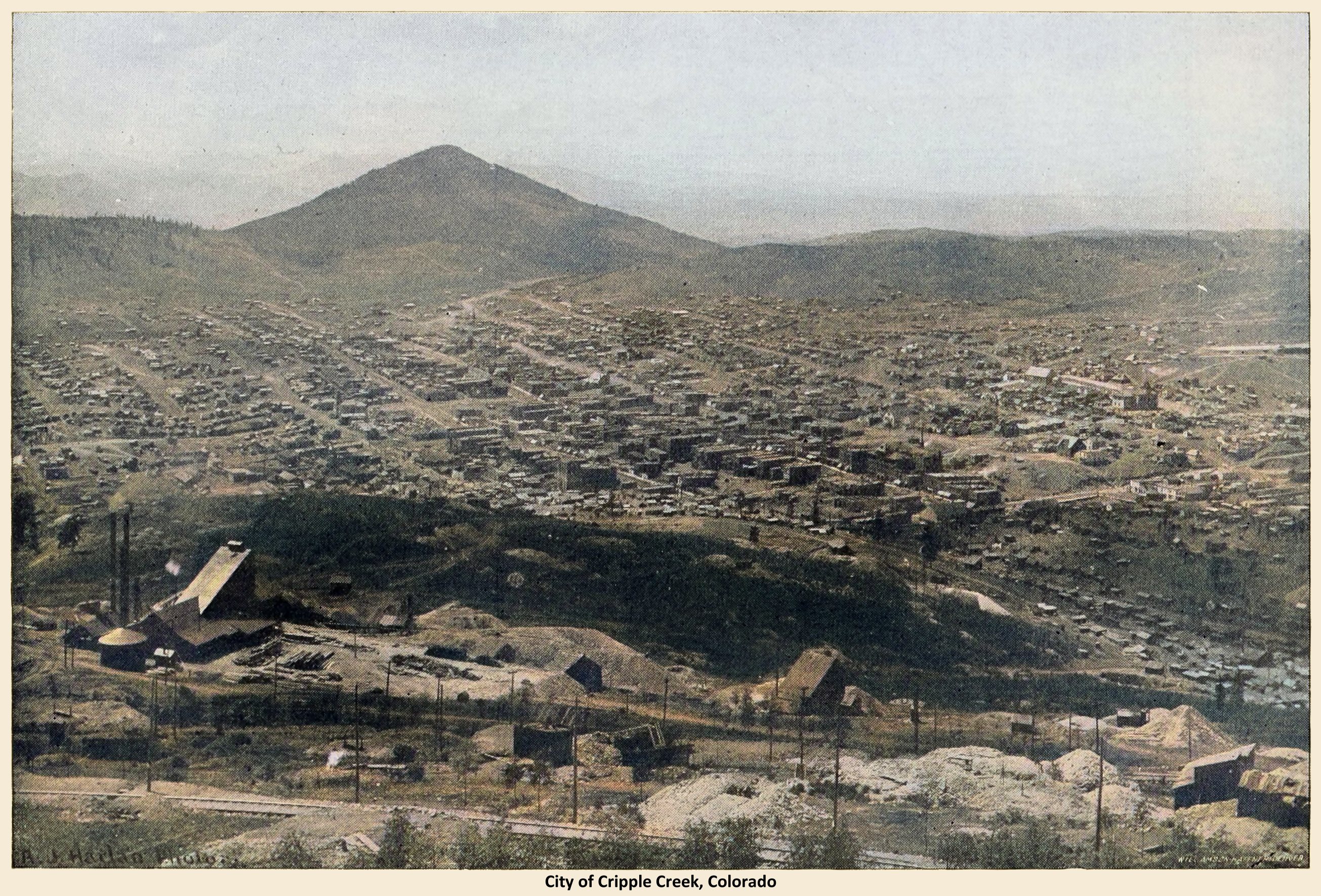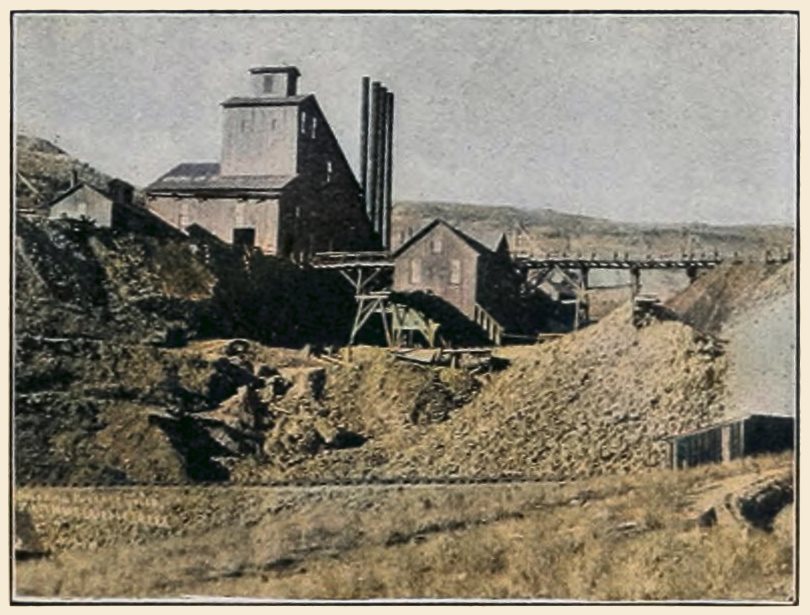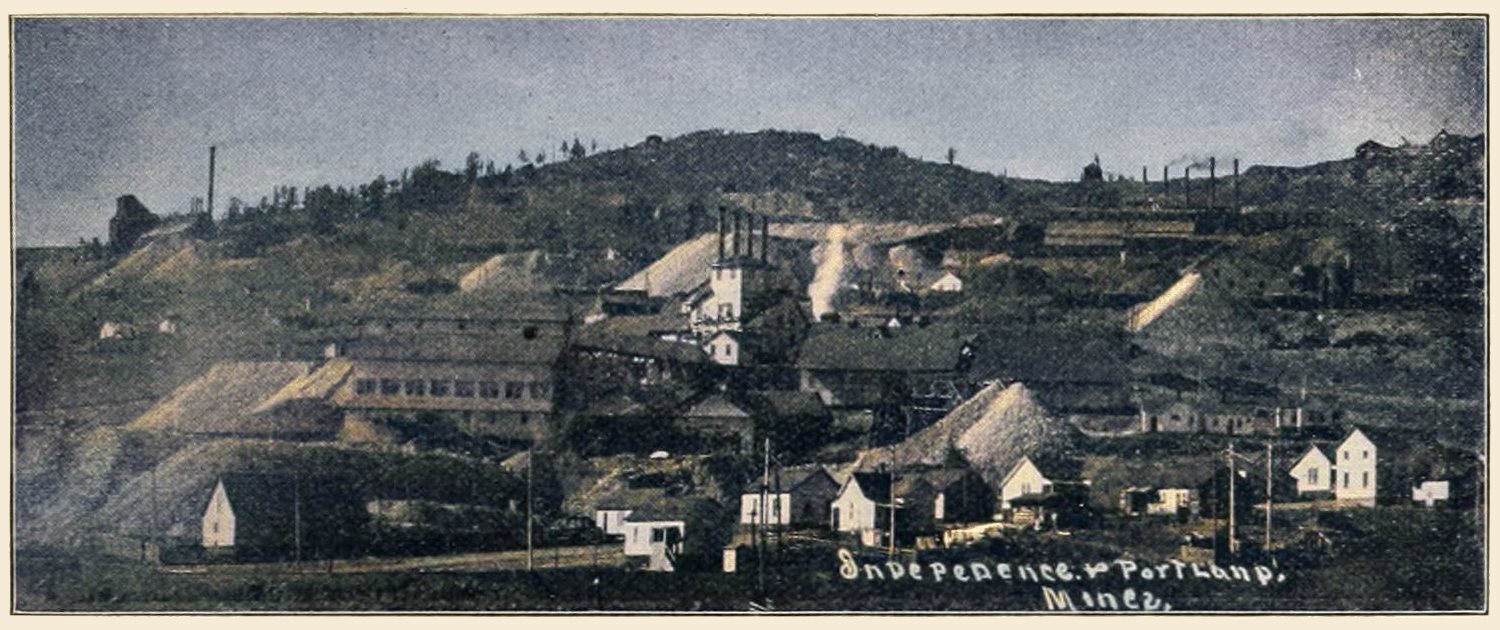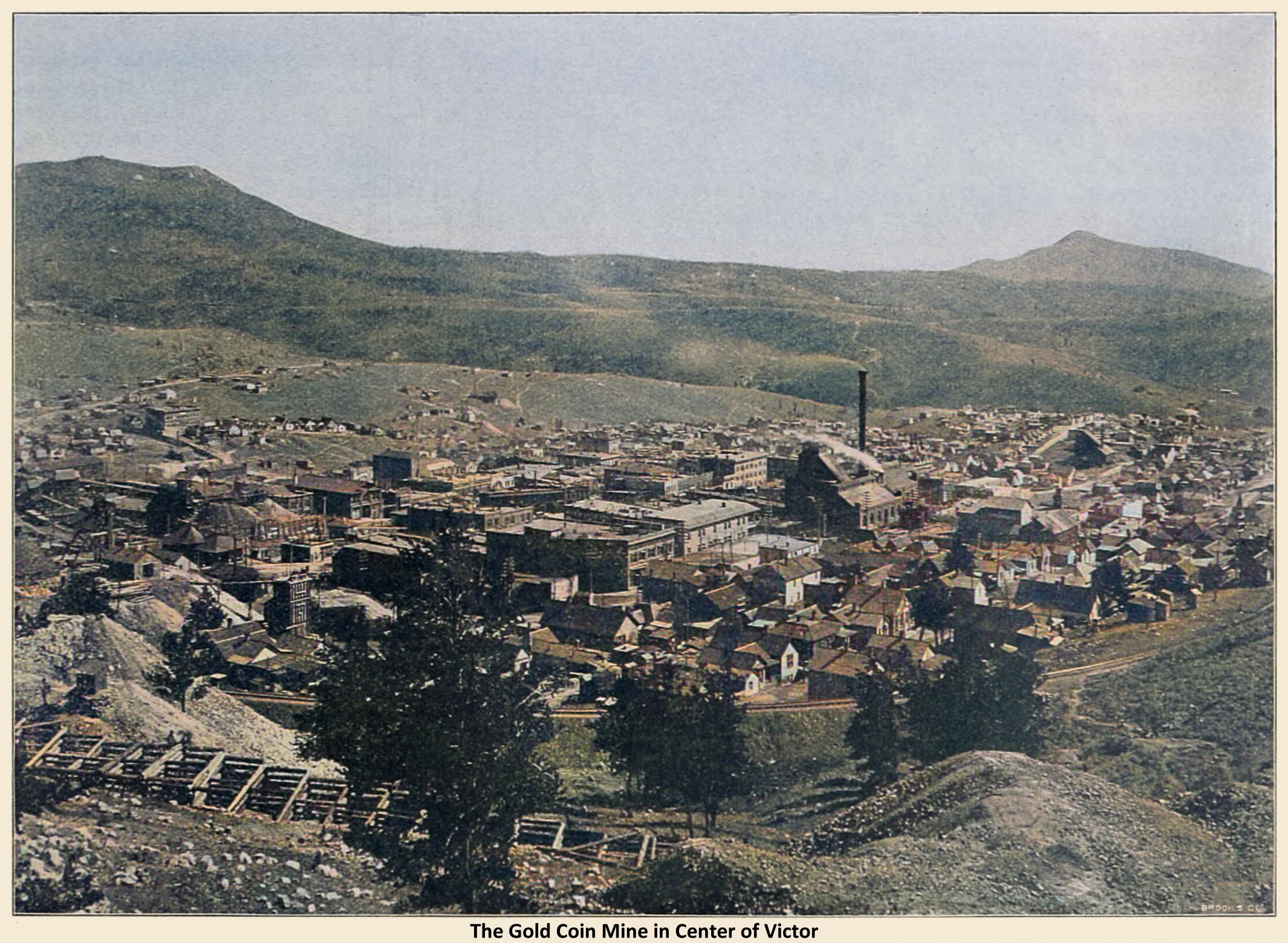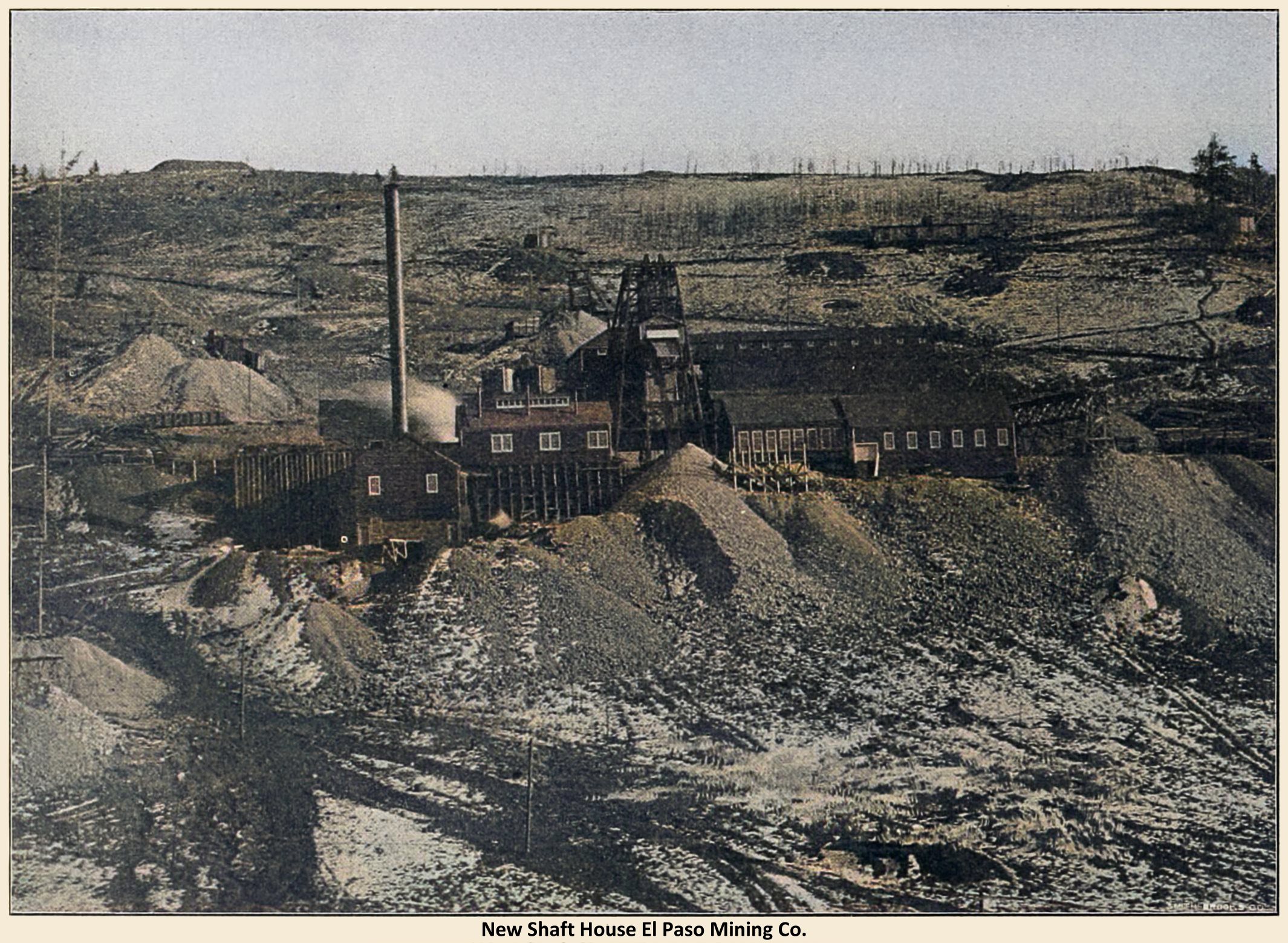-> Can be found at the Internet Archive Site. Link to first page of article.
New Year Edition 1903
(pages 4-6)
I added images from my collection, and procured the coloring of the images, source article had no pics used
 |
Rise of the richest mining district in the world from its beginning,
twelve years ago, furnishes a tale of intense human interest |
 |
The history of the great gold camp reads like a romance. It is a story of engrossing interest, not only to that large element of the world's population to whom the discovery of treasure appeals, but to the student of human achievements and human progress as well.
To the former class the story of Cripple Creek would seem like a page from the Arabian Nights. To the latter, it speaks of the restless search which has been prolonged through the centuries, for that fabled land in which nature had filled her storehouse with golden treasure, El Dorado.
Cripple Creek, a name to conjure with, is known wherever the English tongue is known, a familiar name wherever the yellow metal is regarded as the one great thing to be desired and earnestly sought for. The output of its great mines which has so materially swelled the world's supply of the precious metal, has opened the eyes of the world to the fact that a section of the long-sought El Dorado has been found in the hills which stretch for miles to the westward of that grand old landmark, whose name is synonymous with that of the yellow metal in the minds of the people, Pike's Peak.
When the Argonauts of '49, lured by tales of the discovery of gold on the strand of the great Western sea, united in a mad rush for the gold fields of California, they passed over the Rocky mountain chain, and some of the most adventurous of their number found, in the hills surrounding Pike's Peak, traces of that magnet, which is so infallible in drawing the hearts of men - gold.
But California was to them the El Dorado, and they never dreamed of stopping short of their goal.
The so-called Golden State was rich in the yellow metal, exceedingly rich, and its fame spread to the uttermost confines of the civilized world, but California could not afford to all of the treasure-seekers the wealth they craved and, weary and disgusted, they turned their faces toward the land of the rising sun, drawn by the stories of the existence of gold in the hills lying around about Pike's Peak.
Traveling over the great American desert, long after the fertile fields of the Missouri valley had been left behind, the eye of the pioneer was attracted by a peak which towered above its neighbors like a Gulliver among the Lilliputians. What was more natural than that the traveler should steer his course by such a landmark, or that, reaching its base, he should linger to search the storehouse of Nature for its hidden treasure?
But Nature placed her seal upon the treasure vaults of the great hills and reserved the blessings of a Cripple Creek for a future generation.
At intervals during the years which witnessed the upbuilding of the young commonwealth of Colorado, occasional efforts were made to find out just what was hidden in the clefts and seams of the granite hills of the Cripple Creek region.
There were men who felt sure that the tales of the pioneers about Pike's Peak gold were based upon something more than fancy, and they were confident that they would, sooner or later, unearth the treasure.
In sunshine and shade, midst the balmy days of summer and the chilling blasts of winter, these men persevered in their search. Now and then reports reached the outside world of what searchers were doing, but the world was skeptical and stories of the finding of rich treasure in the hills to the westward of Pike's Peak were laughed to scorn.
How the geologists examined the formation of the hills lying to the west of Pike's Peak, and how the men, versed in the lore of the books, declared that it was impossible to find gold here in paying quantities because the formation was not right, is an old story which has been often told, and the tale, although interesting, is beyond the scope of a work such as this.
The discovery and location of the Cripple Creek district was prefaced by two mining excitements, neither of which amounted to anything, the fact being doubtless due to the difference of conditions here prevailing, from those known in gold-bearing regions.
When the United States geological survey, under the direction of Hayden, was in progress in what is now the Cripple Creek district, H. T. Wood, one of the party, found specimens of gold ore. No attention was paid to the matter at the time, but when Mr. Wood visited Colorado Springs, in 1874, he told of what he had found. In August of that year a party was made up and this party located what is called the Mount Pisgah district.
This was the first attempt to uncover the precious metal in the Cripple Creek region, and again in 1884, another rush was made to Mount Pisgah. Both of the booms were fruitless, and it is a singular fact that to this day, not a mine has been opened in that part of the district which first received the attention of the prospectors, while the territory over which they passed to reach the hoped-for bonanza country, has developed into the most marvelous gold-producing region in the world.
The Weltys settled in the valley of Cripple creek, their home nestling upon the banks of the creek, just below where the Florence & Cripple Creek depot is now located. Their cattle roamed over the hills, waxing fat upon the grass which grew there so luxuriantly.
Then came Bob Womack. This indomitable prospector lingered in the beautiful valley and, day by day, he wandered over the hills, picking up bits of rock which his trained vision told him contained gold. Continuing in his tireless search, at last, in the fall of 1890, he found ore in place up in the region known as Poverty gulch, and he located the El Paso claim, now famous as the Gold King mine.
With a sack full of specimens, he visited Colorado Springs, where he attracted the attention of E. M. De La Vergne and E. C. Frisbee, who visited the district in the winter of 1891. The result of their visit was the opening of the Gold King mine, from which the first shipment of ore was made in November, 1891. The opening of a pay mine stimulated prospecting, and success followed their efforts.
They are the men who really opened and developed the mines of the greatest gold camp on earth.
Discoveries quickly followed the Gold King, and later E. M. De La Vergne opened the Raven mine, on Raven hill, which now belongs to the Elkton Company.
The following spring, in 1893, saw the third great rush to the district, but this time the finds were genuine. Prospecting was started on all the hills, and, with quick succession, mines were opened and their development rapidly pushed.
The Buena Vista, the Mary McKinney, Independence, Anaconda, Victor and Morning Star were among the first mines to become prominent.
Before many months elapsed, all the hills of the district were covered with miners, the results of which the world knows. Of course, the two previous mining excitements caused many to be skeptical, which, to a great extent, kept men of capital out, so the district was developed by the tenderfoot. Work was carried on in a small way, as few had the necessary capital. Ore was found, and it paid the cost of mining, as the work progressed, a condition that all camps can not boast of.
The year 1892 proved to be an important one, and two bonanza producers that have since attracted the attention of the civilized world were opened, the Portland and Stratton's Independence.
Early in the year work was started on what has since proven to be the great Portland mine, and soon thereafter an ore shoot was opened right at the surface. The news of the great Portland strike caused tremendous excitement and people flocked from everywhere to see it. Beginning in that small way the company rapidly increased its holdings, until now it is one of the greatest mining companies in the United States.
One shaft after another was sunk and the great ore bodies demonstrated, until now it is said there is all of twenty millions' worth of ore in sight. Since opening the first ore there have been many surprises in store, even for the management of the company. Ore bodies after ore bodies have been opened, and while considerable of the territory has been prospected there are left many acres of virgin territory.
It was on the fourth day of July, of the same year, that the late W. S. Stratton located the Independence claim. That he did not think much of it at the time was evidenced by the fact that he granted a two months' lease on the claim, while he continued operations on the Washington claim.
The lessees, in the two months that they worked the Independence claim, cleaned up $150,000. When the lease expired Mr. Stratton commenced operations on the Independence, the development of which, a few years later, enabled him to sell the entire property for $10,000,000.
Mining experts, men of great experience in underground work, now began to visit the district. Many made adverse reports. That there was ore they admitted, but many of them put themselves on record that the ore occurred only in surface deposits. They explained how impossible it was for gold to exist in this formation. They turned their backs on the infant camp and left behind them the treasure-vaults long sought for.
Notwithstanding the adverse reports on the camp, the production for 1892 amounted to $600,000. Stock companies were organized and work was carried on with more capital, with the result that the properties were developed faster.
In 1893 silver was demonetized and business generally throughout the state was paralyzed. Miners began to flock here from the great silver camps. Capital was still wary.
Then, like a ray of sunshine through the darkness, came the announcement that the Pharmacist Company, on Bull hill, would pay a dividend.
That news turned the tide to the new El Dorado, and people from every quarter of the globe began arriving. The stage coaches rolled in packed to the boot. The strikes on Gold hill also startled everybody. Over on Battle mountain the Portland was in ore. Money, the profit from mining operations, commenced to circulate for the first time.
The only facility for transporting the ore to market was the wagon. Stamp mills were put up to treat the ore. On account of the peculiar complex condition of the rock, it did not prove to be an ore adapted to the plates or to concentration. Notwithstanding all the difficulties, when the close of the year 1893 came, there had been shipped a total of $2,500,000 worth of ore.
In the succeeding year, 1894, Tutt and Penrose and C. M. McNeill erected a chlorination mill, of 75-tons capacity, at Lawrence, and to them is due the credit of treating the Cripple Creek ores by the chemical process.
The mill burned, and then they went to Colorado City, where they erected their present fine plant, which to-day forms the greatest milling and reduction works in the world. The little mill at Lawrence was kept busy treating ores. The windlass was superseded by the steam plant.
Then came the great strike that tied up nearly every great mine.
In June of 1894 the Florence and Cripple Creek Railroad reached the district. The advent of the road was the cause of much rejoicing, for its coming was recognized as the opening of an era of cheap transportation of ores, and consequently of greater profits to the producers of the yellow metal.
In the early part of the year last mentioned the Gold Coin mine was discovered by the Messrs. Woods. The mine was located in the very heart of the town of Victor, recently established. Two shafts were sunk and some values were found.
The construction of the Victor hotel furnished a surprise, for in cutting a drain under the building a lead of marvelous richness was cut. The Woods brothers located a shaft midway between the two already sunk, and the strike which followed astounded the mining world, so rich was it.
The first shipment of ore from the Gold Coin was made in April, and it was not long before the stock, which had been selling at five cents per share, had gone beyond the dollar mark.
The year closed with a total production for the camp of ore to the value of $4,000,000, while the dividends paid had amounted to slightly over one million dollars.
In the year 1895 the various shafts of the district were driven deeper, and with depth the ore bodies showed up greater in size and of greatly enhanced value. The year, with a record of a production valued at $8,000,000, furnished proof that the greatest gold camp on earth had been discovered.
The Midland Terminal Railroad had been in course of construction for some time, but, owing to the fact that the line had been originally designed as a narrow gauge and that the plans had been changed, the road did not reach the camp until November of 1895.
The year 1896 showed a production valued at $10,000,000, while in 1897 this was swollen to the handsome average of a million dollars a month. As the production increased the dividends showed a corresponding gain, the total for the year being $2,120,395. Heavier machinery was installed, and this in turn has been replaced by other, still greater.
Mine after mine was opened, development was pushed upon the known bonanzas, and when the year 1898 showed an output valued at $16,000,000 the people of the camp began to talk of a yearly output of $20,000,000.
The sale of Stratton's Independence mine caused the eyes of the investing world to again be turned towards the district, and efforts were made to secure the richest tracts of territory, but the owners too well knew the value of their properties, and what sales were made were at the owner's figures.
In 1899, for the second time, bonanza ore was found in the famous Doctor mine on Raven hill. Litigation between the Doctor and the Jack Pot resulted, and this was settled through the consolidation of the two properties, and production was resumed.
The predictions of the sanguine were verified, for 1899 showed a total production valued at $21,000,000.
In the year 1900 W. S. Stratton created considerable comment by purchasing the entire purchasable ground from the limits of the city of Cripple Creek, up Poverty gulch to Hoosier pass. For this Mr. Stratton paid, in round numbers, $3,500,000.
Besides buying Gold and Globe hill acreage, he purchased considerable territory on Bull hill. That Stratton had faith in the future of the district, and especially the north end, he conclusively evidenced.
He started to sink the deepest shaft in the district, the Eagles, on Bull hill, which to-day is 1,540 feet from the collar of the shaft to the bottom of the dump, which is forty feet below the floor of the bottom level.
He took hold of the Abe Lincoln, that had been idle for years, and made it a steady shipper. The breast of the Chicago-Cripple Creek tunnel was pushed ahead and Globe hill developed at great depth.
During the year a number of big consolidations were made. The properties of the Tornado, Raven and Elkton companies were combined into one, giving the new company an immense estate on Raven hill.
As the end of the year drew to a close a consolidation was effected between the Doctor, Jack Pot and Nugget companies, putting to an end forever the costly litigation that was in progress.
When the year 1900 had rounded out the production had reached the enormous sum of $22,500,000.
During the second year of the twentieth century W. S. Stratton started his great work, that would demonstrate to the world that the north end contains great bodies of rich ore.
The Lady Stith shaft, the largest in the district, was started, with three shifts pushing the work of sinking.
A big consolidation was effected in Beacon hill properties by the El Paso company taking in the Kimberly and Cripple Creek-Columbia companies, making a compact group of better than sixty acres of the choicest part of that wonderfully rich little hill.
The work of opening the Deerhorn mine, on Globe, was also started by W. S. Stratton. So great was the ore body uncovered that it was quarried out and shipped without sorting. True, it was of low grade, but such an immense tonnage was made that an enormous profit resulted.
One of the most important developments ever made in the Gold Coin mine happened when what is now called the Dorothy vein was cut, which established beyond a doubt that the ore shoots of that great mine extended downward to indefinite depths.
The production of ore during that year increased to such an extent that heavier hoisting plants of machinery were ordered to replace the ones in use. So large was the tonnage of ore that the cry for freight cars was heard all over the district.
The construction of the Short Line railroad from Colorado Springs was completed early in the spring, and a new avenue of transporting the ores opened.
Milling capacity being needed, the erection of additional chemical plants was started to handle the great output of gold-bearing rock that was hourly hoisted through the deep shafts.
With the close of the year 1901 the mines of the district had made the largest annual contribution in their history, amounting to $24,986,990.
The first decade in the history of Cripple Creek had drawn to a close, and the people proudly stood up and proclaimed to the world the wonderful achievements of its operators, who had transformed a cow pasture into the greatest gold camp on earth in that period, with a record of having produced the enormous sum of $121,286,990.
More wonderful still than that is the fact that there are known ore bodies that will in the next decade yield as much more.
